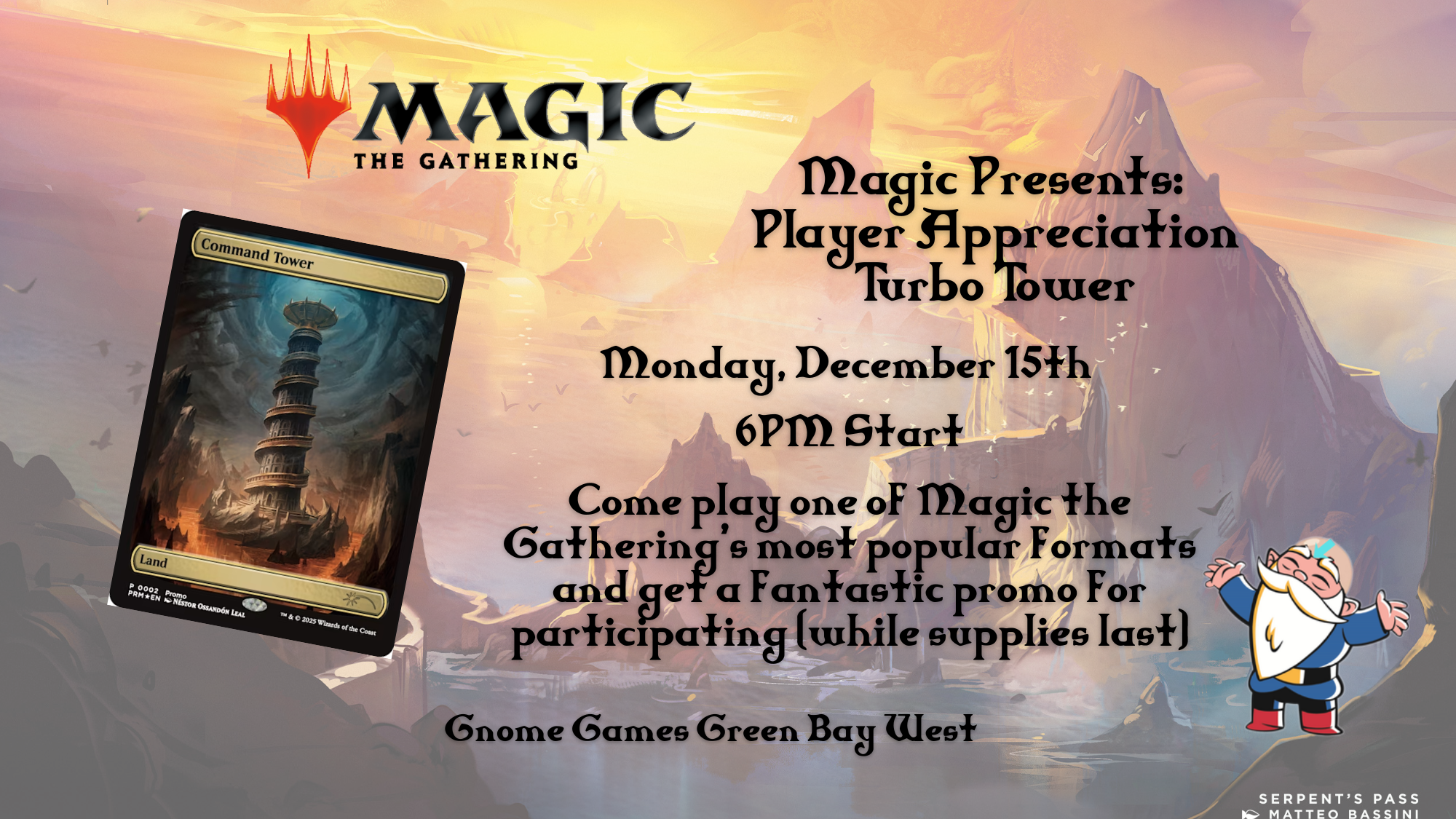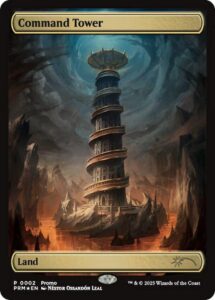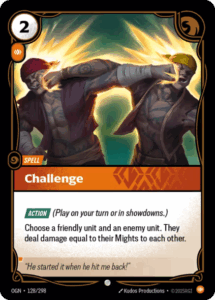 December Pokémon TCG League Challenge – Green Bay East
December Pokémon TCG League Challenge – Green Bay East
Join the Gnomes for a Pokémon Tournament Sunday at Gnome Game Green Bay East!
League Challenge
Registration opens at 12:30pm and begins at 1:00pm
Decklists are required – Download one here
League Challenge Entry:
Juniors (Age 10 & Under) $5
Seniors (11 – 14) $5
Masters $10
This will be a Swiss Rounds only event with each rounds being a best of 1 game match with a 30 minute time limit.
Win a Match Win a Booster, with Promo Packs going out to all players after Round 1.
Championship Points are awarded based on attendance. For more information visit here!
Watch for other events here!

Learn to Play Trio with Gnome Games! Wednesday, December 10th at 7pm, one of the Gnomes will be helping players learn to play the quick and fun card game Trio!
This is a Free event! Seating is limited, but we’re looking to help introduce more players to great games every Wednesday during our Board Game night!
We’ll go over the basics of the game and then jump into playing the game with the Gnome community!
Curious about the game? You can read a few reviews or find videos here while you wait for Wednesday!
Ready to play? Check our calendar for event times and opportunities!

 Welcome Magic Players! Gnome Games and Wizards of the Coast invite you to play in a special Turbo Tower event!
Welcome Magic Players! Gnome Games and Wizards of the Coast invite you to play in a special Turbo Tower event!
Monday, December 15th at 6pm! Event Code: YE2R63J
The Rules
Each player begins the game with a Command Tower promo card on the battlefield. This promo card isn’t counted as part of their deck; their deck still needs to include 100 cards, and it can include another copy of the Command Tower card if they wish.
At the end of the game, each player gets to keep their Commander Tower promo card! (While supplies last!)
Look for these and more events like it on our website: www.gnomegames.com/events/month
 Will you become the next Avatar? The Commander Party for Avatar: The Last Air Bender gives you a chance!
Will you become the next Avatar? The Commander Party for Avatar: The Last Air Bender gives you a chance!
Monday, January 12th at 6pm we invite players to play together with the Avatar Commander Party set of rules!
Eventcode: DWRM587
Each player who joins in will get a promo Gran-Gran! (While supplies last.)
GAMEPLAY: The play aid has four sections, one for each of the four bending elements. At the beginning of the first player’s third turn, each player puts their
marker on the element closest to them. Whenever a player meets the conditions on their element, they master that element and advance their marker clockwise to the next element. If a player would master an element they already mastered this game, they enter the avatar state instead.
For more information on the Commander Format visit https://magic.wizards.com/en/formats/commander
“This format is for four players per game and deck sizes are 99 cards + 1 commander card. The game duration for this format should be about 20 minutes per player.
The Commander format is all about picking your hero and building a deck around them. In this casual, multiplayer format, you choose a legendary creature to serve as your commander and build the rest of your deck around their color identity and unique abilities. Players are only allowed one of each card in their deck, with the exception of basic lands, but they can use cards from throughout Magic’s history.”
Current Commander Banned list.
Join our other events by checking out our calendar!
 Will you become the next Avatar? The Commander Party for Avatar: The Last Air Bender gives you a chance!
Will you become the next Avatar? The Commander Party for Avatar: The Last Air Bender gives you a chance!
Monday, December 8th at 6pm we invite players to play together with the Avatar Commander Party set of rules!
Eventcode: RZDJ45R
Each player who joins in will get a promo Gran-Gran! (While supplies last.)
GAMEPLAY: The play aid has four sections, one for each of the four bending elements. At the beginning of the first player’s third turn, each player puts their
marker on the element closest to them. Whenever a player meets the conditions on their element, they master that element and advance their marker clockwise to the next element. If a player would master an element they already mastered this game, they enter the avatar state instead.
For more information on the Commander Format visit https://magic.wizards.com/en/formats/commander
“This format is for four players per game and deck sizes are 99 cards + 1 commander card. The game duration for this format should be about 20 minutes per player.
The Commander format is all about picking your hero and building a deck around them. In this casual, multiplayer format, you choose a legendary creature to serve as your commander and build the rest of your deck around their color identity and unique abilities. Players are only allowed one of each card in their deck, with the exception of basic lands, but they can use cards from throughout Magic’s history.”
Current Commander Banned list.
Join our other events by checking out our calendar!

 Join the Gnomes on Saturdays at 12:30pm for a Riftbound Nexus Tournament!
Join the Gnomes on Saturdays at 12:30pm for a Riftbound Nexus Tournament!
3 rounds of play, with Win-A-Match, Win-A-Pack prizing!
Each match will be best 2 of 3, 50 minute round.
This is a casual Local Constructed tournament with Swiss rounds!
Nexus Night promo packs will be awarded based on availability!
Here are some pertinent tournament rules to follow!
You may have a sideboard, following official rules:
- In constructed format’s, a player’s sideboard must be exactly 0 or 8 cards.
- 403.3. A sideboard can consist only of valid Main Deck cards.
- 403.4. Limits on copies of named cards apply to the combination of Main Deck and sideboard.
- 403.5. Players may use those cards to modify their deck after the first game of a match.
- 403.5.a. During that time, a player may change their Chosen Champion to one from their sideboard or main deck that matches their Legend.
- 403.5.b. A player may not change their Legend or Battlefields at any point after deck registration.
- 403.5.c. A player’s Main Deck must be exactly 40 cards after this process.
- 403.6. Players may not use sideboard cards in the first game of a match.
Match
- 404.1. A match of Riftbound consists of a series of games that are played until one side has won a predetermined number of games.
- 404.2. Most matches of Riftbound are “best of 3,” meaning the predetermined number of games to win is 2.
- 404.3. Games that end in a draw do not count toward this goal.
- 404.4. If the competition round ends (due to time limits) prior to any side achieving the goal, the winner of the match is the one who has won the most games.
- 404.5. If all sides have equal game wins, the match is a draw.
408. End of Match Procedure
- 408.1. A match is complete once a match result is recorded by players or a tournament official.
- 408.2. If the time limit for a competition round is reached before a winner is determined, the player whose turn it is finishes their turn.
- 408.2.a. After that player’s turn is complete, five additional turns are played, and then the match ends.
- 408.2.b. If the game is incomplete at the end of the additional turns, the winner of the game is the one with the highest score. If scores are tied, the game is a draw.
- 408.2.c. Additional turns are untimed, but at high OPL a judge must be present to ensure a reasonable pace of play.
- 408.2.d. If the players are between games when the round time ends, no new game is started.
Links
Fridays you may want to come in and playtest, and Saturdays are for tournaments! Watch for both on our calendar: www.gnomegames.com/events/month
You’ll want to stay up to date with the most current errata or rules changes, some of which is available here: https://riftbound.leagueoflegends.com/en-us/news/rules-and-releases/riftbound-origins-card-errata/
If you’re looking for help building decks you might like information from the designers: https://riftbound.leagueoflegends.com/en-us/news/rules-and-releases/deckbuilding-primer/

 Join the Gnomes on Saturdays at 12:30pm for a Riftbound Nexus Tournament!
Join the Gnomes on Saturdays at 12:30pm for a Riftbound Nexus Tournament!
3 rounds of play, with Win-A-Match, Win-A-Pack prizing!
Each match will be best 2 of 3, 50 minute round.
This is a casual Local Constructed tournament with Swiss rounds!
Nexus Night promo packs will be awarded based on availability!
Here are some pertinent tournament rules to follow!
You may have a sideboard, following official rules:
- In constructed format’s, a player’s sideboard must be exactly 0 or 8 cards.
- 403.3. A sideboard can consist only of valid Main Deck cards.
- 403.4. Limits on copies of named cards apply to the combination of Main Deck and sideboard.
- 403.5. Players may use those cards to modify their deck after the first game of a match.
- 403.5.a. During that time, a player may change their Chosen Champion to one from their sideboard or main deck that matches their Legend.
- 403.5.b. A player may not change their Legend or Battlefields at any point after deck registration.
- 403.5.c. A player’s Main Deck must be exactly 40 cards after this process.
- 403.6. Players may not use sideboard cards in the first game of a match.
Match
- 404.1. A match of Riftbound consists of a series of games that are played until one side has won a predetermined number of games.
- 404.2. Most matches of Riftbound are “best of 3,” meaning the predetermined number of games to win is 2.
- 404.3. Games that end in a draw do not count toward this goal.
- 404.4. If the competition round ends (due to time limits) prior to any side achieving the goal, the winner of the match is the one who has won the most games.
- 404.5. If all sides have equal game wins, the match is a draw.
408. End of Match Procedure
- 408.1. A match is complete once a match result is recorded by players or a tournament official.
- 408.2. If the time limit for a competition round is reached before a winner is determined, the player whose turn it is finishes their turn.
- 408.2.a. After that player’s turn is complete, five additional turns are played, and then the match ends.
- 408.2.b. If the game is incomplete at the end of the additional turns, the winner of the game is the one with the highest score. If scores are tied, the game is a draw.
- 408.2.c. Additional turns are untimed, but at high OPL a judge must be present to ensure a reasonable pace of play.
- 408.2.d. If the players are between games when the round time ends, no new game is started.
Links
Fridays you may want to come in and playtest, and Saturdays are for tournaments! Watch for both on our calendar: www.gnomegames.com/events/month
You’ll want to stay up to date with the most current errata or rules changes, some of which is available here: https://riftbound.leagueoflegends.com/en-us/news/rules-and-releases/riftbound-origins-card-errata/
If you’re looking for help building decks you might like information from the designers: https://riftbound.leagueoflegends.com/en-us/news/rules-and-releases/deckbuilding-primer/

 Join the Gnomes on Saturdays at 12:30pm for a Riftbound Nexus Tournament!
Join the Gnomes on Saturdays at 12:30pm for a Riftbound Nexus Tournament!
3 rounds of play, with Win-A-Match, Win-A-Pack prizing!
Each match will be best 2 of 3, 50 minute round.
This is a casual Local Constructed tournament with Swiss rounds!
Nexus Night promo packs will be awarded based on availability!
Here are some pertinent tournament rules to follow!
You may have a sideboard, following official rules:
- In constructed format’s, a player’s sideboard must be exactly 0 or 8 cards.
- 403.3. A sideboard can consist only of valid Main Deck cards.
- 403.4. Limits on copies of named cards apply to the combination of Main Deck and sideboard.
- 403.5. Players may use those cards to modify their deck after the first game of a match.
- 403.5.a. During that time, a player may change their Chosen Champion to one from their sideboard or main deck that matches their Legend.
- 403.5.b. A player may not change their Legend or Battlefields at any point after deck registration.
- 403.5.c. A player’s Main Deck must be exactly 40 cards after this process.
- 403.6. Players may not use sideboard cards in the first game of a match.
Match
- 404.1. A match of Riftbound consists of a series of games that are played until one side has won a predetermined number of games.
- 404.2. Most matches of Riftbound are “best of 3,” meaning the predetermined number of games to win is 2.
- 404.3. Games that end in a draw do not count toward this goal.
- 404.4. If the competition round ends (due to time limits) prior to any side achieving the goal, the winner of the match is the one who has won the most games.
- 404.5. If all sides have equal game wins, the match is a draw.
408. End of Match Procedure
- 408.1. A match is complete once a match result is recorded by players or a tournament official.
- 408.2. If the time limit for a competition round is reached before a winner is determined, the player whose turn it is finishes their turn.
- 408.2.a. After that player’s turn is complete, five additional turns are played, and then the match ends.
- 408.2.b. If the game is incomplete at the end of the additional turns, the winner of the game is the one with the highest score. If scores are tied, the game is a draw.
- 408.2.c. Additional turns are untimed, but at high OPL a judge must be present to ensure a reasonable pace of play.
- 408.2.d. If the players are between games when the round time ends, no new game is started.
Links
Fridays you may want to come in and playtest, and Saturdays are for tournaments! Watch for both on our calendar: www.gnomegames.com/events/month
You’ll want to stay up to date with the most current errata or rules changes, some of which is available here: https://riftbound.leagueoflegends.com/en-us/news/rules-and-releases/riftbound-origins-card-errata/
If you’re looking for help building decks you might like information from the designers: https://riftbound.leagueoflegends.com/en-us/news/rules-and-releases/deckbuilding-primer/

Disney Lorcana Illumineer’s League- Gnome Games Appleton North
Explore the wonderous world of Disney Lorcana with your fellow Illumineers every Monday! Join us from 4pm-8pm during our Disney Lorcana Illumineer’s League to play with a favorite deck (or build a new one), trade, or just hang out with your fellow Illumineers. This event is an Open play style of event for all ages, where promos will be given out randomly to participants.
Entry for this event is $5 or the purchase of $5 in Disney Lorcana Product.
Looking for something more competitive? We’ll also be running a 3 Round tournament beginning at 5:30pm.

Disney Lorcana Illumineer’s League- Gnome Games Appleton North
Explore the wonderous world of Disney Lorcana with your fellow Illumineers every Monday! Join us from 4pm-8pm during our Disney Lorcana Illumineer’s League to play with a favorite deck (or build a new one), trade, or just hang out with your fellow Illumineers. This event is an Open play style of event for all ages, where promos will be given out randomly to participants.
Entry for this event is $5 or the purchase of $5 in Disney Lorcana Product.
Looking for something more competitive? We’ll also be running a 3 Round tournament beginning at 5:30pm.
 December Pokémon TCG League Challenge – Green Bay East
December Pokémon TCG League Challenge – Green Bay East


 Welcome Magic Players! Gnome Games and Wizards of the Coast invite you to play in a special Turbo Tower event!
Welcome Magic Players! Gnome Games and Wizards of the Coast invite you to play in a special Turbo Tower event! Will you become the next Avatar? The Commander Party for Avatar: The Last Air Bender gives you a chance!
Will you become the next Avatar? The Commander Party for Avatar: The Last Air Bender gives you a chance!
 Join the Gnomes on Saturdays at 12:30pm for a Riftbound Nexus Tournament!
Join the Gnomes on Saturdays at 12:30pm for a Riftbound Nexus Tournament!